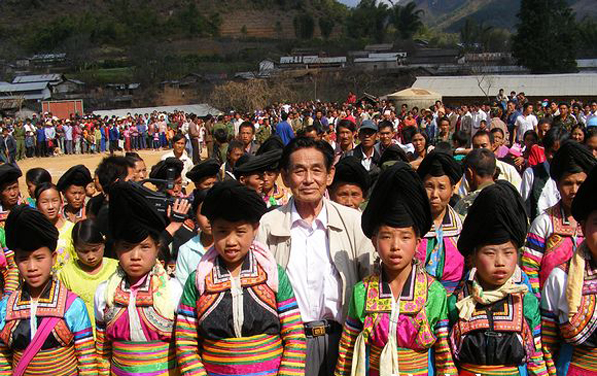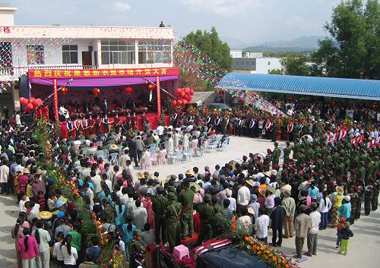Kokang Celebrate Liberation from Burmese Communists

The Myanmar National Democratic Alliance Army (MNDAA), a Kokang cease-fire group, started celebrations of its 20th anniversary of liberation from the Communist Party of Burma (CPB) on Wednesday in the Sino-Burmese border town of Laogai.
Aung Kyaw Zaw, a Burmese military analyst on the Sino-Burmese Border who is close to the Kokang, said the MNDDA started the three-day anniversary period in northern Shan State.
 |
| A Chinese-style ceremony marks the opening of a school in Kokang territory in February. (Photo: www.kokang.net) |
“Kokang leader Peng Jiasheng (Burmese: Phon Kyar Shin) gave a 30-minute speech to a crowd at 8 a.m. at a stadium in Laogai,” he said.
Khuensai Jaiyen, the editor in chief of The Shan Herald Agency for News, told The Irrawaddy that representatives of Kachin and Shan armed groups, and Wa and Mongla representatives as well, were scheduled to attend the Kokang anniversary this week.
Twenty years ago, Kokang commanders in the army of the CPB performed a coup against the Community Party, mainly dominated by Burmans.
Aung Kyaw Zaw said that when the Kokang separated from the CPB there were an estimated 900 troops with Kokang commanders.
“But the Kokang partition from the CPB significantly wobbled the CPB leadership because the Kokang were well-know during the Communist military operations as well as their influential Chinese background,” he said.
About a month later, Wa troops, another military backbone of the Burmese Communists, performed a coup in Panghsang, headquarters of the CPB. Later, the Wa formed the United Wa State Army (UWSA). The UWSA is scheduled to hold its 20th anniversary of separation from the CPB on April 17.
The Kokang and Wa rebellions against the Burmese Communists turned a new page in Burma’s history by effectively dismantling the CPB, Burma’s biggest insurgent group, which had a significant impact on the Burmese army’s anti-insurgency operations.
Following of cease-fire, the Kokang, Wa, Mongla and New Democratic Army-Kachin (NDAK) formed an alliance group, the Peace and Democracy Front (PDF) in November 1989.
After a cease-fire with the Kokang and Wa, the Burmese military focused its offensive to win more cease-fire pledges and to isolate other insurgents in different parts of the country. Between 1989 to 1995, under the supervision of military intelligence chief Gen Khin Nyunt, the junta signed cease-fire agreements with 17 insurgent groups.
For nearly 20 years, there were internal conflicts among Kokang leaders. Some prominent commanders were killed or removed from the leaderships during the conflict. One Kokang leader was arrested by Burmese troops after the Kokang army split up, and later he died in prison.
“Although Kokang commanders were respected in battle [in the past], they split up. And then Kokang power was weaken. Burmese troops took over areas of the Kokang region, and now the Kokang are not as strong,” Khuensai Jaiyen said.
According to The Shan Herald Agency for News, the junta has established a Regional Operations Command (ROC) with seven infantry battalions in Kokang territory.
In recent months, the junta has pushed Burma’s ceasefire groups, including the Kokang and Wa, to participate in the forthcoming election in 2010. The junta reportedly encouraged them to give up their arms in the post-election period. So far, the Kokang and Wa have not announced their intentions on the election.
Ahead of the anniversary, Kokang leaders highlighted their community development plans during the past two decades and the benefits to the Kokang people.
However, Khuensai Jaiyen expressed skepticism on Kokang development efforts. He said Kokang leaders have benefited more than the Kokang people.
Along with the Wa, the Kokang are believed to be involved in the drug trade according to international anti-narcotic agencies. Kokang leaders claim its territory was drug free beginning in 2003.
- 'My Wife Died From Police Abuse,' Says Husband
- US Says Observer Conditions Don't Meet Int'l Standards
- 159 Observers to Monitor Burma Election
- Govt to Address Breaches of SSA-South Ceasefire: Aung Min
- Burma Investors Pin Hopes on Seminal Sunday
- Malaysia PM Leads 50-Strong Delegation to Burma
- US Congress to Assess Burma's Political Prisoner Issue
- Rangoon Woman in Police Station Death Plunge
- Burmese Legal System Remains Tool of Govt: AHRC
- Burmese Army Chief Defends Political Role
